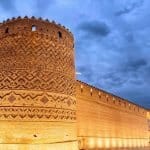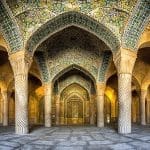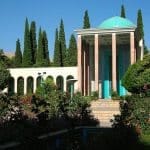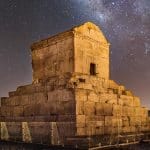In the heart of Ardabil, a historic city in northwestern Iran, stands one of the nation’s most treasured spiritual and architectural masterpieces — the Sheikh Safi al-Din Ardabili’s Khānegāh and Shrine Ensemble. This remarkable complex unites Sufi mysticism, Persian architectural brilliance, and Islamic artistry in perfect harmony. Built between the 14th and 18th centuries, it honors Sheikh Safi al-Din Ardabili (1252–1334), the revered founder of the Safavid Sufi order and spiritual ancestor of the Safavid dynasty.
Beyond its architectural splendor, the ensemble became a center of spiritual learning and pilgrimage, drawing mystics, poets, and travelers from across Persia and neighboring lands. It also served as the final resting place of several Safavid kings and soldiers, symbolizing the enduring connection between faith, leadership, and devotion.
The design of Sheikh Safi al-Din’s Shrine Ensemble reflects the Sufi path toward enlightenment. Pilgrims pass through seven courtyards, representing the seven stages of spiritual purification, and eight gates, each symbolizing one of the Sufi virtues.
Highlights of the complex include:
The Tomb of Sheikh Safi al-Din, crowned by the magnificent Allah-Allah Dome, adorned with turquoise tiles and sacred inscriptions.
The Chinī Khāneh (Porcelain House), built under Shah Abbas I, a treasure chamber decorated with fine plasterwork and colorful tiles that once held rare Chinese porcelains.
The Jannat Sara Mosque, a place of prayer and gathering for Sufi followers.
The Shahidgah, the resting place of Safavid warriors who lost their lives defending their faith and homeland.
Every corner of the ensemble — from muqarnas vaults and arabesque tile patterns to wooden doors carved with calligraphy — reveals the exquisite craftsmanship of Safavid artisans and the spiritual essence embedded in Persian design.
A visit to Sheikh Safi al-Din Ardabili’s Shrine Ensemble is a journey through centuries of faith and artistry. As you step through the gates and courtyards, you trace the same spiritual path once walked by Sufi pilgrims in search of divine truth. The soft light filtering through lattice windows, the cool stone corridors echoing with whispers of prayer, and the glimmer of glazed tiles together create an atmosphere of profound tranquility.
For travelers, this UNESCO World Heritage Site is more than a monument — it is an experience of inner peace and cultural discovery. Standing within its ancient courtyards, one can sense the mystic rhythm of Sufi tradition and the grandeur of the Safavid dynasty.
A visit to Ardabil would not be complete without exploring this sacred ensemble, where history, art, and spirituality intertwine.
he Sheikh Safi al-Din Ardabili’s Khānegāh and Shrine Ensemble is located in the city of Ardabil, the capital of Ardabil Province in northwestern Iran. Reaching this UNESCO World Heritage Site is convenient thanks to good road, air, and bus connections from major Iranian cities.
By Air
Ardabil Airport (ADU) is the nearest airport, situated about 15 kilometers from the city center. It offers regular domestic flights from Tehran, and seasonal flights from Mashhad and other major cities. From the airport, visitors can reach the shrine by taxi or private transfer in about 20 minutes.
By Road
Ardabil is well connected by scenic highways that wind through the mountains of the Alborz range.
From Tehran, the distance is approximately 590 kilometers, a 7 to 8-hour drive via Qazvin and Khalkhal or through Zanjan.
From Tabriz, it is around 210 kilometers, taking about 3 hours by car or bus.
From Rasht, the journey covers about 270 kilometers, crossing lush mountain roads with breathtaking views.
Long-distance buses run daily from Tehran’s West Terminal, as well as from Tabriz, Rasht, and other northern cities directly to Ardabil’s main bus terminal.
By Train
Ardabil does not yet have a direct railway station; however, travelers can take a train to Tabriz and continue by bus or private car to Ardabil.
Local Transportation
Once in Ardabil, reaching the Sheikh Safi al-Din Shrine Ensemble is simple. The site is located in the old quarter of the city, close to Ardabil Bazaar and easily accessible by taxi or on foot from the city center. Signs and local guides are available for visitors.
The best time to visit Sheikh Safi al-Din Ardabili’s Khānegāh and Shrine Ensemble is during the mild months of late spring and early autumn, when Ardabil’s mountain climate is at its most pleasant.
Spring (April to June)
Spring transforms Ardabil into a land of fresh air, blooming gardens, and cool sunshine. Temperatures range between 10°C and 22°C, creating perfect conditions for sightseeing and strolling through the historical quarters around the shrine. The surrounding mountains are lush and green, making this season the most popular among travelers.
Summer (July to early September)
Unlike most regions of Iran, Ardabil enjoys a cool and refreshing summer, thanks to its high altitude. This makes it an ideal retreat from the heat of the central and southern provinces. Daytime temperatures rarely exceed 25°C, and evenings are pleasantly cool. Many domestic travelers visit during this period, so booking accommodations in advance is recommended.
Autumn (September to November)
Autumn brings crisp weather and fewer crowds, offering a quiet and reflective atmosphere around the shrine. The changing colors of the nearby forests along the Asalem–Khalkhal road add a scenic touch for those traveling by car. Temperatures remain moderate, ideal for both cultural exploration and nature excursions.
Winter (December to March)
Ardabil experiences cold winters with occasional snowfall. While the shrine remains open year-round, the cold and icy roads may make travel less convenient. However, winter offers a serene and peaceful ambiance for those who wish to experience the site in solitude and enjoy the city’s traditional winter cuisine.





